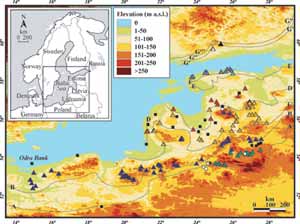Study Offers Preview of Ice Sheet Melting, Rapid Climate Changes

The main extents of the Scandinavian Ice Sheet are shown in this digital elevation model of the sampling area outlined in gray. The letters and triangles represent different sampling sites. Image credit: adapted from The Land Processes Distributed Active Archive Center
Behavior of Scandinavian Ice Sheet at the end of the last Ice Age may preview loss of Greenland Ice Sheet due to global warming
The retreat of a massive ice sheet that once covered much of northern Europe has been described for the first time, and researchers believe it may provide a sneak preview of how present-day ice sheets in Greenland and Antarctica will act in the face of global warming.
The study, which appears in the current issue of the journal Science, was led by researchers from the Lamont-Doherty Earth Observatory and Oregon State University and contributed to by scientists from eight European institutes. They conclude that ice sheets in different parts of the world can react quite differently as the Earth warms.
“When we look at the Scandinavian Ice Sheet, we sometimes see it actually growing larger and sometimes rapidly disappearing, depending on whether increased snow offsets melting effects or not,” said Vincent Rinterknecht, a post-doctoral research scientist at Lamont-Doherty Earth Observatory who is the study’s lead author and who conducted much of the research while he was a doctoral student at Oregon State. “Our work showed that it actually grew for a long period while the climate was warming but still very cold, and then rapidly disintegrated once the climate warmed even further.”
The authors say the same dynamics of climate change and ice sheet growth may be at work today and probably mean that in the face of future global warming, ice across large portions of Antarctica may actually increase volume, but not at a rate that will counterbalance projected losses to the massive Greenland ice sheet. By itself, and without any offsetting mechanisms, a collapse of the Greenland ice sheet would raise global sea levels by about 20 to 25 feet. There is also concern that the rapid injection of large amounts of fresh water into this part of the North Atlantic Ocean may interfere with the ocean circulation system that is responsible for keeping much of Europe warm.
The timing of the ice sheet’s retreat has, until now, been poorly understood because of the relatively few radiocarbon dated sites in the region. In their study, the researchers used a technique to determine the time that rocks have been exposed to cosmic rays from outer space, which pass through the Earth’s atmosphere but cannot penetrate ice to any great depth. Using the method, known as cosmogenic surface exposure dating, Rinterknecht and his colleagues measured the amount of an isotope of the element beryllium, 10Be, formed when cosmic rays strike the surface of a rock. Knowing the rate at which 10Be forms and decays allowed the scientists to accurately determine how long a rock surface has been exposed and, therefore, when the ice sheet likely retreated.
The huge Scandinavian Ice Sheet the scientists studied once covered much of Northern Europe and formed during the most recent Ice Age, which lasted from about 100,000 to 10,000 years ago. At its peak it was about 6,000 feet thick and, after the ice sheet in North America, was the largest in the Northern Hemisphere. The researchers combined climate information, largely obtained from ice cores drilled in Greenland, with sea level records and records of deep-sea sediments to create a larger picture of how the ice sheet fluctuated within a changing climate.
The study was supported by the National Science Foundation’s Paleoclimate Program and the French Institut National de Physique Nuclèaire et de Physique de Particules and Institut National des Sciences de l’Univers.
The Earth Institute at Columbia University is the world’s leading academic center for the integrated study of Earth, its environment and society. The Earth Institute builds upon excellence in the core disciplines — earth sciences, biological sciences, engineering sciences, social sciences and health sciences — and stresses cross-disciplinary approaches to complex problems. Through research, training and global partnerships, it mobilizes science and technology to advance sustainable development, while placing special emphasis on the needs of the world’s poor. For more information, visit www.earth.columbia.edu.
The Lamont-Doherty Earth Observatory, a member of The Earth Institute at Columbia University, is one of the world’s leading research centers seeking fundamental knowledge about the origin, evolution and future of the natural world. More than 200 research scientists study the planet from its deepest interior to the outer reaches of its atmosphere, on every continent and in every ocean. From global climate change to earthquakes, volcanoes, nonrenewable resources, environmental hazards and beyond, Observatory scientists provide a rational basis for the difficult choices facing humankind in the planet’s stewardship.
Media Contact
More Information:
http://www.ldeo.columbia.edu http://www.columbia.edu http://www.earth.columbia.eduAll latest news from the category: Ecology, The Environment and Conservation
This complex theme deals primarily with interactions between organisms and the environmental factors that impact them, but to a greater extent between individual inanimate environmental factors.
innovations-report offers informative reports and articles on topics such as climate protection, landscape conservation, ecological systems, wildlife and nature parks and ecosystem efficiency and balance.
Newest articles

How marine worms regenerate lost body parts
The return of cells to a stem cell-like state as the key to regeneration. Many living organisms are able to regenerate damaged or lost tissue, but why some are particularly…

Nano-scale molecular detective
New on-chip device uses exotic light rays in 2D material to detect molecules. Researchers have developed a highly sensitive detector for identifying molecules via their infrared vibrational “fingerprint”. Published in Nature…

Novel CAR T-cell therapy
… demonstrates efficacy and safety in preclinical models of HER2-positive solid tumors. The p95HER2 protein is found expressed in one third of HER2+ tumors, which represent 4% of all tumors….



